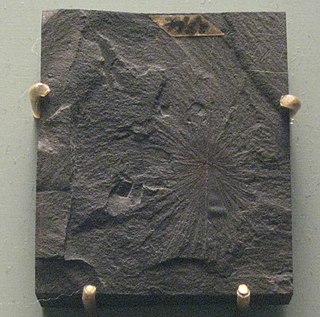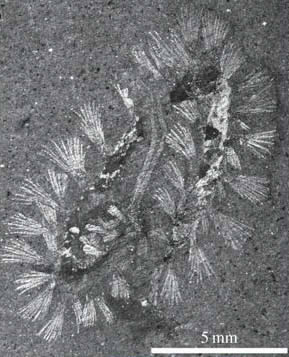
The Burgess Shale is a fossil-bearing deposit exposed in the Canadian Rockies of British Columbia, Canada. It is famous for the exceptional preservation of the soft parts of its fossils. At 508 million years old, it is one of the earliest fossil beds containing soft-part imprints.

Kootenia is a genus of trilobites of the family Dorypygidae. 118 specimens of Kootenia are known from the Greater Phyllopod bed, where they comprise 0.22% of the community. Its major characteristics are that of the closely related Olenoides, including medium size, a large glabella, and a medium-sized pygidium, but also a lack of the strong interpleural furrows on the pygidium that Olenoides has.

The Wapta Icefield is a series of glaciers located on the Continental Divide in the Waputik Mountains of the Canadian Rockies, in the provinces of British Columbia and Alberta, in Yoho National Park in the Canadian Rockies. The icefield is shared by Banff and Yoho National Parks and numerous outlet glaciers extend from the icefield, including the Vulture, Bow and Peyto Glaciers. Runoff from the icefields and outlet glaciers supply water to both the Kicking Horse and Bow Rivers, as well as numerous streams and lakes.

Choia is a genus of extinct demosponge ranging from the Cambrian until the Lower Ordovician periods. Fossils of Choia have been found in the Burgess Shale in British Columbia; the Maotianshan shales of China; the Wheeler Shale in Utah; and the Lower Ordovician Fezouata formation. It was first described in 1920 by Charles Doolittle Walcott.

Leanchoilia is a megacheiran arthropod known from Cambrian deposits of the Burgess Shale in Canada and the Chengjiang biota of China.

Helmetia is an extinct genus of arthropod from the middle Cambrian. Its fossils have been found in the Burgess Shale of Canada and the Jince Formation of the Czech Republic.

Odaraia is a genus of bivalved arthropod from the Middle Cambrian. Its fossils, which reach 15 centimetres (5.9 in) in length, have been found in the Burgess Shale in British Columbia, Canada.

Burgessia is a genus of arthropod known from the mid-Cambrian aged Burgess Shale of British Columbia, Canada. It is relatively abundant, with over 1,700 specimens having been collected.

Burgessochaeta is an extinct genus of polychaete annelids from the Middle Cambrian. Its fossils have been found in the Burgess Shale in British Columbia, Canada. A total of 189 specimens of Burgessochaeta are known from the Greater Phyllopod bed, where they comprise 0.36% of the community. Specimens have also been found at Marble Canyon. The genus was described by Conway Morris (1979) and re-examined by Eibye-Jacobsen (2004).
The Burgess Shale of British Columbia is famous for its exceptional preservation of mid-Cambrian organisms. Around 69 other sites have been discovered of a similar age, with soft tissues preserved in a similar, though not identical, fashion. Additional sites with a similar form of preservation are known from the Ediacaran and Ordovician periods.
A number of assemblages bear fossil assemblages similar in character to that of the Burgess Shale. While many are also preserved in a similar fashion to the Burgess Shale, the term "Burgess Shale-type fauna" covers assemblages based on taxonomic criteria only.
Yuknessia is an early pterobranch, known from the Burgess shale, the Chengjiang and the Wheeler shale. Long, unbranched fronds emerge from a central holdfast-like body covered in small conical plates. 23 specimens of Yuknessia are known from the Greater Phyllopod bed, where they comprise < 0.1% of the community. The genus contains two species: the type species Y. simplex and Y. stephenensis. It was originally interpreted as a green alga, and has since been reinterpreted it as a colonial pterobranch.

Marrellomorpha are an extinct group of arthropods known from the Cambrian to the Early Devonian. They lacked mineralised hard parts, so are only known from areas of exceptional preservation, limiting their fossil distribution. The best known member is Marrella, with thousands of specimens found in the Cambrian aged Burgess Shale of Canada. The group is divided up into two major orders, Marrellida and Acercostraca. Marrellida is recognised by the possession of head shields with two or three pairs of elongate spine-like projections, and three pairs of uniramous appendages on the cephalon, while Acercostraca generally have large ovoid carapaces that cover the entire upper half of the body, and five pairs of uniramous cephalic appendages. Both groups have unbranched antennules and a segmented trunk with biramous appendages. Recent research has suggested the previously enigmatic Cambrian trilobite-like arthropods Skania and Primicaris belong to this group. Their phylogenetic position is uncertain, various studies have alternatively placed them in the Arachnomorpha as relatives of Artiopoda, as related to Mandibulata, or as stem group euarthropods.

Hazelia is a genus of spicular Cambrian demosponge known from the Burgess Shale, the Marjum formation of Utah, and possibly Chengjiang. It was described by Charles Walcott in 1920.
The Phyllopod bed, designated by USNM locality number 35k, is the most famous fossil-bearing member of the Burgess Shale fossil Lagerstätte. It was quarried by Charles Walcott from 1911–1917, and was the source of 95% of the fossils he collected during this time; tens of thousands of soft-bodied fossils representing over 150 genera have been recovered from the Phyllopod bed alone.

Molaria is a genus of Cambrian arthropod, the type species M. spinifera is known from the Middle Cambrian Burgess Shale. 144 specimens of Molaria are known from the Greater Phyllopod bed, where they comprise 0.27% of the community. A second species M. steini was described from the Sirius Passet in Greenland in 2017.

Micromitra is a genus of brachiopods known from the Middle Cambrian Burgess Shale. 160 specimens of Micromitra are known from the Greater Phyllopod bed, where they comprise 0.3% of the community.

Oryctocephalus is a genus of trilobite known from the Middle Cambrian Burgess Shale. 24 specimens of Oryctocephalus are known from the Greater Phyllopod bed, where they comprise 0.42% of the community. This small- to medium-sized trilobite's major characteristics are prominent eye ridges, pleural spines, long genal spines, spines on the pygidium, and notably four furrows connecting pairs of pits on its glabella. Juvenile specimens have been found with only 5 or 6 thoracic segments and about one eighth of adult size, as well as about 2 mm wide.
Protospongia is a genus of Porifera known from the Middle Cambrian Burgess Shale. 102 specimens of Protospongia are known from the Greater Phyllopod bed, where they comprise 0.19% of the community.

Tegopelte gigas is a species of large soft-bodied arthropod known from two specimens from the Burgess Shale. Trackways that may have been produced by this organism or a close relative are known from the Kicking Horse Shale, stratigraphically below its body fossil occurrences. T. gigas is the only species classified under the genus Tegopelte. It is usually classified under its own family Tegopeltidae, but is sometimes placed under the family Naraoiidae. It is currently considered a member of Conciliterga within the Artiopoda.














